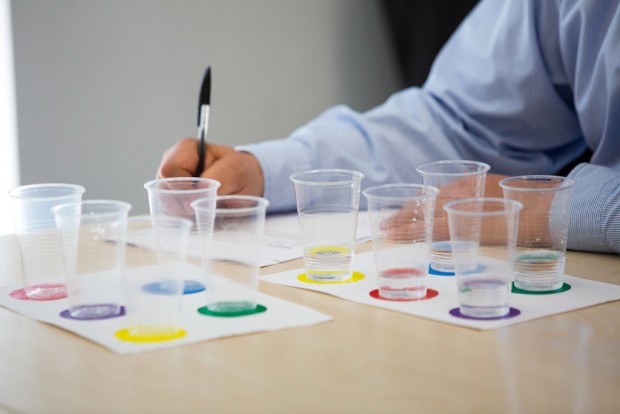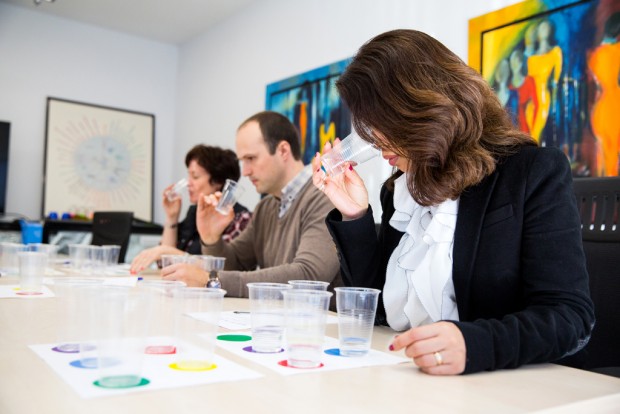
Coffee sensory standards are added to water for key off flavors, such as “fermented” or “baggy.” Photo courtesy of FlavorActiv.
The global sensory standards company FlavorActiv has for the first time directly addressed the coffee industry, with plans to introduce its own approach toward a unified language of sensory evaluation.
In a presentation titled, “Coffee Sensory: Time for a New, Global Approach?” at the 3rd International Congress on Coffee, Cocoa and Tea in Aveiro, Portugal, late last month, the company introduced its new sensory analysis kit, which will see wider release later in 2015 and purports to offer a platform for simple, standardized sensory evaluation to coffee tasters, the same way previous kits have for craft brewers.
The UK-based firm originated with a focus on the brewing industry, and has expanded to develop sensory tasting standards and equipment for use by makers of beer, wine, cider, spirits, soft drinks and water.
“We are making this move because we think there is nothing like this currently available for the coffee industry,” FlavorActiv Head of Coffee Sensory Dr. Javier Gomez-Lopez told Daily Coffee News following the debut of the kit. “One thing that was clear from the congress last month is that that there is a problem developing standardization in this industry. There is not an agreed set of flavor descriptors, which other industries have.”
That appears to be changing, with numerous efforts in the past two years from various stakeholders in the coffee industry who have introduced new approaches to evaluation generally based around the concept of shared language. On the cupping front, we’ve seen this in Sustainable Harvest’s Tastify cupping app and Counter Culture’s taster’s flavor wheel.
“The beer industry, for example, developed a common language 40 years ago, followed by a set of chemical standards to use in training,” Gomez-Lopez said. “The problem is, if you use descriptive analysis without a common language, two different tasters could be using two different words that may or may not be the same flavor.”
FlavorActiv’s push comes on the heels of another sensory standardization effort based on similar principles called the Coffee Sensory Lexicon, which was announced by World Coffee Research just one month earlier, in May. The strategy of the Lexicon is to develop a common language using specific products as reference flavors, such as widely available brands of canned food. Dr. Gomez-Lopez is familiar with this effort and considers it an important first step.
“It’s really important that the industry has a common and accepted lexicon,” said Gomez-Lopez. “However, once you have that, you need a standardized way to train testers to recognize the terms in the lexicon. Our flavor standards are in powder form. They are calibrated so that, when you add them to one liter of beverage, they increase the concentration of that flavor note to a certain defined level. They are designed to be both smelled and tasted, combining the nose, mouth and retronasal effect. It’s a complete sensory experience that helps people train themselves to recognize these notes.”
While coffee is a longstanding and global industry, Gomez-Lopez suggests that the dominance of major roasters with relatively few production facilities, coupled with the existence of so many smaller independent roasters, has resulted in limited drive towards universal sensory analysis standardization.
“In the brewing industry, some big companies manufacture one product in 200 different plants all over the world,” said Gomez-Lopez. “They need something very certain to ensure that every single taster in these 200 plants speaks the same language.”
The company’s coffee standards categorize defects into two essential types: Off flavors and contaminants. Off flavors occur naturally, whereas contaminant flavors are imparted by some external source. Much of the coffee kit’s development will focus on defects, which Gomez-Lopez says can be linked to the process.
“You know what the flavor is and you know where it comes from so you can correct it,” said Gomez-Lopez. “At the moment we’re focusing on ‘off’ flavors because it’s probably the easiest way to go into the market. I think there is more consensus about the off notes than there are for positive notes, which are more complex. In the future we’ll develop a kit for positive notes.”
FlavorActiv has partnered with Vermont consultancy Coffee Enterprises and London roaster Square Mile to identify the flavors most relevant to coffee tasting. They are developing these into a training kit that will contain a core selection of flavors and is expected to be released around October 2015. The exact price of the coffee kit has not yet been finalized, although it is expected to be comparable to that of their introductory beer kit, which costs $75.
Alex Owen-Hill
Alex Owen-Hill writes about science, beverages and anything else fascinating. He is based in Edinburgh, UK. @AlexOwenHill
Comment
1 Comment
Comments are closed.








Que interesante .